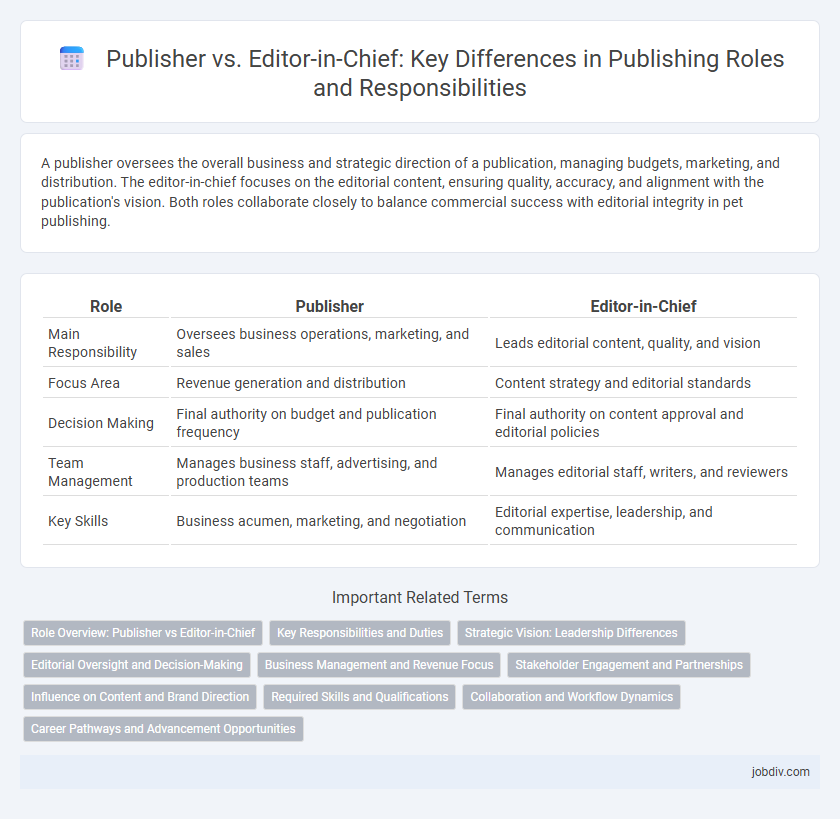A publisher oversees the overall business and strategic direction of a publication, managing budgets, marketing, and distribution. The editor-in-chief focuses on the editorial content, ensuring quality, accuracy, and alignment with the publication's vision. Both roles collaborate closely to balance commercial success with editorial integrity in pet publishing.
Table of Comparison
| Role | Publisher | Editor-in-Chief |
|---|---|---|
| Main Responsibility | Oversees business operations, marketing, and sales | Leads editorial content, quality, and vision |
| Focus Area | Revenue generation and distribution | Content strategy and editorial standards |
| Decision Making | Final authority on budget and publication frequency | Final authority on content approval and editorial policies |
| Team Management | Manages business staff, advertising, and production teams | Manages editorial staff, writers, and reviewers |
| Key Skills | Business acumen, marketing, and negotiation | Editorial expertise, leadership, and communication |
Role Overview: Publisher vs Editor-in-Chief
The publisher oversees the overall business strategy, financial management, and distribution channels, ensuring profitability and market reach of the publication. The editor-in-chief directs the editorial vision, content quality, and journalistic integrity, managing writers and editors to maintain the publication's voice and credibility. Both roles collaborate closely to balance commercial success with editorial excellence.
Key Responsibilities and Duties
The Publisher oversees the overall business strategy, financial management, and distribution channels, ensuring the publication's profitability and market presence. The Editor-in-Chief manages the editorial content, maintains quality standards, and directs the editorial team to align with the publication's vision and audience interests. Both roles collaborate to balance commercial success with editorial integrity, optimizing content delivery and reader engagement.
Strategic Vision: Leadership Differences
The publisher drives the overall business strategy, focusing on revenue growth, market expansion, and brand positioning, while the editor-in-chief shapes the editorial vision, ensuring content quality, relevance, and journalistic integrity. Publishers oversee financial and operational management, enabling long-term sustainability, whereas editors-in-chief lead newsroom teams, set editorial policies, and maintain the publication's voice. Both roles require strategic leadership but differ in scope, with publishers emphasizing commercial success and editors-in-chief prioritizing content excellence.
Editorial Oversight and Decision-Making
The Publisher holds ultimate responsibility for the financial and strategic direction of a publication, ensuring overall business viability and market positioning. The Editor-in-Chief manages editorial oversight by guiding content strategy, maintaining editorial standards, and leading the editorial team in decision-making on story selection and journalistic integrity. While the Publisher focuses on business goals and revenue, the Editor-in-Chief prioritizes editorial quality and audience relevance.
Business Management and Revenue Focus
The Publisher holds overall responsibility for the business management and revenue generation of a publication, overseeing advertising sales, distribution, and financial strategies to ensure profitability. In contrast, the Editor-in-Chief concentrates on editorial content, maintaining quality and editorial standards without direct involvement in revenue operations. While the Publisher drives the commercial success and sustainability of the publication, the Editor-in-Chief ensures the publication's integrity and audience engagement through content direction.
Stakeholder Engagement and Partnerships
Publishers play a crucial role in stakeholder engagement by managing relationships with investors, authors, and distribution partners to ensure aligned business objectives. Editors-in-Chief focus on partnerships with editorial teams, reviewers, and content creators to maintain publication quality and integrity. Effective collaboration between both roles enhances brand reputation and drives successful publication outcomes.
Influence on Content and Brand Direction
The Publisher holds ultimate authority over the financial and strategic direction of the publication, shaping the brand's overall vision and market positioning. The Editor-in-Chief directs the editorial content, ensuring it aligns with the brand's voice and journalistic standards while influencing audience engagement. Together, they collaborate to balance commercial goals and editorial integrity, directly impacting the publication's reputation and reader loyalty.
Required Skills and Qualifications
Publishers require strong business acumen, marketing expertise, and leadership skills to oversee production, distribution, and financial management of publishing houses. Editors-in-Chief need advanced editorial judgment, content strategy proficiency, and excellent communication abilities to guide editorial teams and maintain quality standards across publications. Both roles demand a deep understanding of the publishing industry and proven experience in managing teams and projects effectively.
Collaboration and Workflow Dynamics
The Publisher oversees the overall business strategy and financial health of the publication, while the Editor-in-Chief manages the editorial vision and content quality. Effective collaboration between them ensures alignment of commercial goals with editorial integrity, streamlining decision-making and resource allocation. Their dynamic partnership facilitates a cohesive workflow that balances audience engagement, market trends, and journalistic standards.
Career Pathways and Advancement Opportunities
Publishers typically advance through roles in business development, production management, and marketing, leveraging strong leadership and strategic planning skills to oversee entire publishing operations. Editors-in-Chief progress by gaining extensive editorial experience, mastering content curation, and managing editorial teams, which opens opportunities to lead prestigious publications or transition into senior editorial consultancy roles. Both career pathways offer advancement potential, but publishers often focus on the commercial and operational growth of publishing houses, while Editors-in-Chief concentrate on maintaining content quality and editorial vision.
Publisher vs Editor-in-Chief Infographic

 jobdiv.com
jobdiv.com